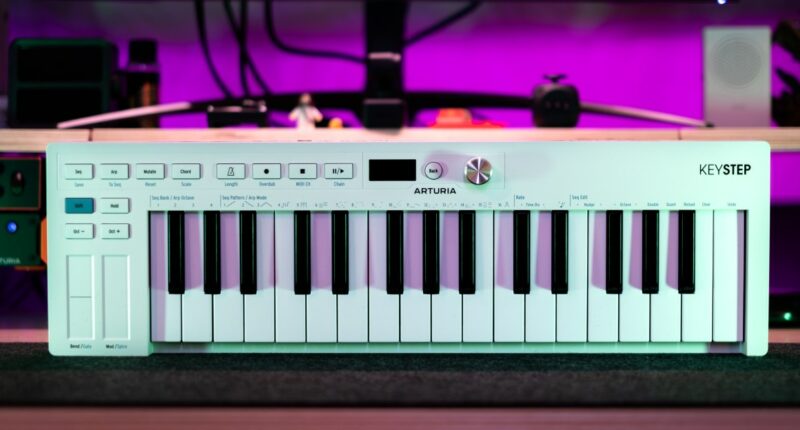Share this @internewscast.com
Arturia’s KeyStep has long been a favorite among MIDI controllers, especially for fans of modular synths and those who steer clear of digital audio workstations (DAWs). Praised for its compact size, affordability, user-friendly sequencer, and solid connectivity, the KeyStep has been a staple since its debut in January 2016. While the music technology landscape evolves at a slower pace compared to industries like smartphones, Arturia’s newer controllers have already reached their third iterations. Enter the $139 KeyStep mk2, a refreshed version that enhances the classic with a variety of sequencing and composition tools Arturia has honed over the years.
The KeyStep mk2 significantly expands on its predecessor, offering double the arpeggiator modes—16 in total—and an impressive eightfold increase in sequencer save slots, now numbering 64. It also introduces generative sequencing features, along with chord and scale modes. The scale mode is particularly beneficial for less experienced musicians, ensuring every note remains in key. However, while helpful, some might find it feels a bit unnatural on a traditional keyboard layout, though it works well on pad controllers.
For me, the standout features are the new arpeggiator modes and the innovative Spice and Mutate functions, which bring fresh energy to the sequencer. These tools are incredibly useful when I’m creatively blocked or uninspired, providing a pathway to generating ideas that goes beyond mere randomness in note generation.
Creativity often hinges on achieving a flow state, a process that demands time and dedication. Yet, with life’s various demands, such as work and family, finding this state can be challenging. The KeyStep’s generative and iterative capabilities help bridge this gap, making it easier to dive into the creative process when time is limited.
My creative sessions often start with a simple arpeggio. I select a chord consisting of three or four notes and press the mutate button. This action begins to shift the notes, introducing octave jumps and rests, effectively adding an element of unpredictability. A brief press introduces subtle variations, while holding it longer can transform the original arpeggio entirely.
After experimenting with mutations, I often adjust the Spice value. This feature alters the gate length and injects note ratchets, adding another layer of complexity. If the initial Spice adjustments don’t resonate, I press shift and tap the Spice touchstrip three times to generate a new set of random variations, allowing me to fine-tune the results using the Spice parameter.

Once I have a short phrase I like, I can then save it to the sequencer, and this is where things get more interesting. I can duplicate the phrase, extending the sequence to 32 or even 64 steps. And, since the KeyStep’s sequencer is polyphonic, I can record overdubs, playing counter melodies, chords, or basslines alongside this semi-random sequence.
I might quickly press the Mutate button again here or fine-tune the Spice setting, but once I have a fuller-sounding passage I like, I can pass it back to the arpeggiator by selecting the “user sequence” arp mode. This uses the last sequence loaded as the basis for your arpeggio. It doesn’t just play the notes, though. It maps the sequence’s pattern onto whatever notes you play. If you play the same notes, it will sound the same, but it’s much more fun to play entirely new chords or a chord progression. If you have a chord progression for a song, but feel like it sounds a bit lifeless, this could be a great way to liven it up.
Now, when I’m feeling stuck, I don’t waste 30 minutes noodling and scrolling through presets or feeling discouraged because my drum pattern is too boring. I just start playing. The point isn’t even necessarily to use whatever sequence or arp I play on the KeyStep, though I often do. Instead, it’s just about making something — anything — and seeing where my creative impulses take me next.
Arturia smartly kept the price and basic design more or less the same — 32 keys in a shallow body with minimal hands-on controls. But there are some obvious differences. The knobs and switch for controlling the sequencer and arpeggiator have been replaced with some lightly clicky buttons, and there’s now an endless encoder and a small OLED in the middle of the keyboard.
Physically, the biggest change is to the build quality, and it’s not a good thing. While the KeyStep mk2 doesn’t feel cheap, it’s certainly not up to the standards of the original. The OG KeyStep had a metal base. It was much heavier than you’d expect from looking at it, and it felt like it could not only endure the rigors of tour life, but also be used as a self-defense weapon. The mk2 trades the metal base for plastic, and the controls just feel less solid overall.
That’s my only real complaint, though.
The KeyStep mk2 isn’t a magic bullet that will cure your writer’s block or put you in a flow state immediately. But it’s already proven to be a handy tool when I’m feeling discouraged or uninspired while staring at a blank Ableton Live session.





